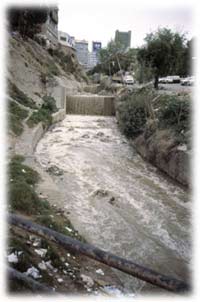
|
 |

Why
was the Safe Water System Developed?

 In
2000, just 10 years after the end of the Water and Sanitation Decade, the lack
of access to safe water remains a problem for more than a billion people in the
developing world. Annually, 2 to 3 million children less than 5 years old die
of diarrheal diseases, a large proportion of which are acquired through exposure
to contaminated water. In addition, after 39 years, the 7th pandemic of cholera
continues unabated, claiming the lives of a high percentage of children and adults
who acquire the disease. There are a number of reasons for the persistence of
these proble In
2000, just 10 years after the end of the Water and Sanitation Decade, the lack
of access to safe water remains a problem for more than a billion people in the
developing world. Annually, 2 to 3 million children less than 5 years old die
of diarrheal diseases, a large proportion of which are acquired through exposure
to contaminated water. In addition, after 39 years, the 7th pandemic of cholera
continues unabated, claiming the lives of a high percentage of children and adults
who acquire the disease. There are a number of reasons for the persistence of
these proble ms
in spite of the investment of billions of dollars in safe water by donor agencies
and governments. Population shifts from rural to urban areas have stressed existing
water and sanitary infrastructure and exceeded the capacity of most countries
to keep up with demand. Large population dislocations caused by armed conflict
and natural disasters have created enormous logistical problems in providing water
and sanitation services, as have dispersed populations and poor transportation
infrastructure in many rural areas. While larger scale projects, such as the construction
of deep wells or piped water systems, remain an important objective of many development
agencies, a shortage of time and resources will leave hundreds of millions of
people without access to safe water into the foreseeable future. To help bridge
the enormous gap in developing countries between populations served by existing
water projects and those most in need, the Centers for Disease Control and Prevention
(CDC) and the Pan American Health Organization developed the Safe Water System,
a simple, inexpensive, adaptable, and flexible intervention that employs technologies
appropriate for the developing world. ms
in spite of the investment of billions of dollars in safe water by donor agencies
and governments. Population shifts from rural to urban areas have stressed existing
water and sanitary infrastructure and exceeded the capacity of most countries
to keep up with demand. Large population dislocations caused by armed conflict
and natural disasters have created enormous logistical problems in providing water
and sanitation services, as have dispersed populations and poor transportation
infrastructure in many rural areas. While larger scale projects, such as the construction
of deep wells or piped water systems, remain an important objective of many development
agencies, a shortage of time and resources will leave hundreds of millions of
people without access to safe water into the foreseeable future. To help bridge
the enormous gap in developing countries between populations served by existing
water projects and those most in need, the Centers for Disease Control and Prevention
(CDC) and the Pan American Health Organization developed the Safe Water System,
a simple, inexpensive, adaptable, and flexible intervention that employs technologies
appropriate for the developing world.
 |
 | |